
Apparently after using the toilet to poop, if you stand up to flush, the swirling water will send a fine mist of water droplets into the air which will contain tiny particles of fecal matter. These droplets will be deposited on all the surfaces near your toilet, including the sink, your toiletries, and most importantly, your toothbrush! This is similar to what happens when someone sneezes or farts. Here is a brief summary of this topic from the U.S. National Library of Medicine: "The studies demonstrate that potentially infectious aerosols may be produced in substantial quantities during flushing. Aerosolization can continue through multiple flushes to expose subsequent toilet users. Some of the aerosols desiccate to become droplet nuclei and remain adrift in the air currents. However, no studies have yet clearly demonstrated or refuted toilet plume-related disease transmission, and the significance of the risk remains largely uncharacterized".We're going to find out how much aerosolization occurs by doing a simple experiment. Clearly there are a number of variables here which we can't control, notably the size of the toilet and the strength of the flush. We'll do our best with the toilet we have. There is also the variability in poop size and texture; we speculate that diarrhea would probably provide the greatest droplet dispersal when flushing the toilet. Needless to say, we're not going to try to control that variable. If you're interested in how poop is produced, visit our page about the intestines. We'll simulate fecal matter in the toilet water with two varieties of fluorescent materials, a liquid and a powder. Both are non-toxic. These will show up using a small UV flashlight. We will invesigate the results after just one flush. The bathroom: 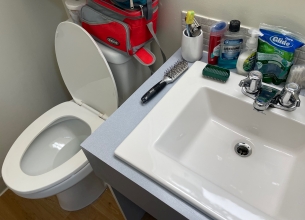
 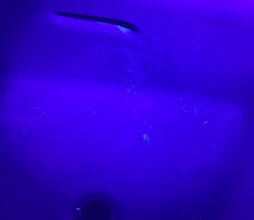 All surfaces were thoroughly cleaned. We used our UV flashlight to check for anything that might fluoresce, but found nothing. (As you'll see later, fluorescent material will show up as white specks in the UV light photos.) Trial 1: Fluorescent liquid 

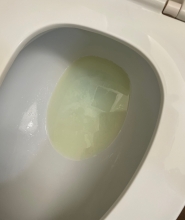
We deposited a copious amount of fluorescent liquid on the surface of the water in the toilet. It created a yellowish film, and much of it remained on the surface. We turned off the lights and flushed the toilet. Here's what we saw: 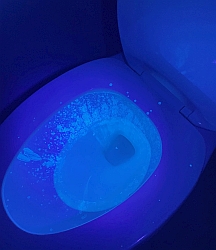
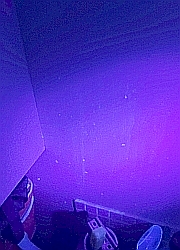
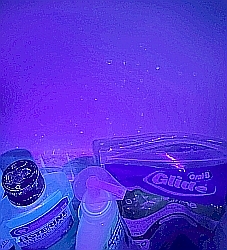
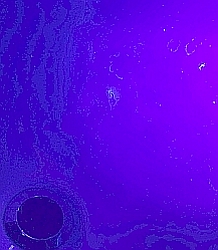
There was clearly a large amount of the fluorescent liquid which had been aerosolized and deposited everywhere. The inside of the toilet, as you would expect, was covered. Disconcertingly, so was the sink, the wall over the sink, and all of the toiletries on the back of the sink, including my toothbrush! [This was difficult to capture in photos; the images had to be manipulated considerably to bring out the spatters that were easily apparent to the eye.] Trial 2: Fluorescent powder 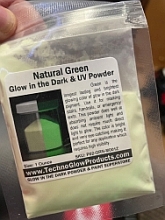 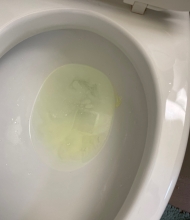 We redid the test with this material to see if the powder would distribute itself differently around the bathroom, with the thought that it might more closely simulate actual poopy water. It did seem to accumulate more on the surface of the water. 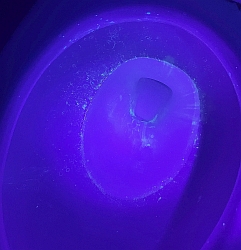 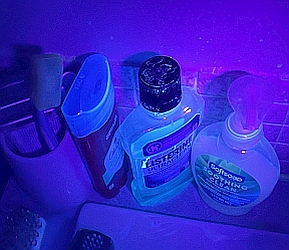 Once again we had to heavily process these photos to make the spatter visible. It's worth pointing out that what was visible to the eye was very clear, and perhaps even more brightly that is shown here, making it obvious that our eyes are far better at seeing in the dark than an iPhone camera! There was little difference here from the first trial. Specks of fluorescent material, simulating fecal matter, were all over the sink and the toiletries at the back of the sink. Conclusions Clearly whatever was in the toilet bowl was aerosolized and spread around the bathroom. We will assume that if the water contained poopy stuff, bits of that would do the same. Flushing the toilet while standing up and with the lid up will deposit bits of fecal matter on your toothbrush, as well as anything else on your sink. The remedy for this disgusting fact is to either stay sitting or put the lid down when you flush. I also now keep my toothbrush in a small cover. |
 Answering the age-old question:
Answering the age-old question: